How Art Schools Shape Creative Thinkers in the Digital Age
Creativity holds greater significance in an age dominated by technology and swift innovation. Concept art schools are instrumental in cultivating creative thinkers by providing students with the necessary skills to thrive in the digital realm. In contrast to conventional education, which often emphasises memorisation, art institutions promote critical thinking, problem-solving, and flexibility—vital attributes for success in today’s world.
The Transforming Function of Art Schools
Concept art schools have progressed beyond merely instructing in classical painting, sculpture, and fine arts. Nowadays, they incorporate digital fields like graphic design, animation, game design, and interactive media, ensuring that students stay pertinent in a progressively digital marketplace.
This interdisciplinary strategy connects artistic creativity with technological progress, equipping students for a variety of career paths.
How Art Schools Encourage Innovation and Critical Thought
- Project-Based Learning: Art education prioritises practical projects, enabling students to explore, revise, and enhance their concepts. This methodology not only fosters creativity but also sharpens problem-solving abilities.
- Collaborative Interdisciplinary Work: Students engage in collaborative projects that intertwine art with technology, business, and science. This nurtures a comprehensive approach to learning, where creativity intersects with practical implementation.
- Promoting Risk-Taking and Exploration: Unlike inflexible educational structures, art schools create an atmosphere where students feel secure in taking risks, trying out new concepts, and learning from mistakes—fundamental elements of innovation.
Digital Tools and Technologies in Art Education
- Integration of Digital Design and AI: Contemporary art institutions offer training in AI-enhanced design tools, 3D modelling, and UX/UI design, ensuring students are adept with state-of-the-art technologies.
- Virtual and Augmented Reality (VR/AR): Art schools utilize VR/AR technologies, enabling students to craft immersive experiences that extend the limits of storytelling and visual communication.
- Online Learning and Global Collaboration: Through digital platforms, students can work with peers and professionals worldwide, gaining insights from various viewpoints and broadening their creative networks.
- Creative Coding and Interactive Media: As coding becomes an indispensable skill for artists, numerous programs introduce students to creative coding, generative design, and interactive installations, allowing them to merge technology and artistry effortlessly.
Developing Essential 21st-Century Competencies
- Flexibility and Resilience: The iterative nature of artistic endeavors teaches students to embrace obstacles, push through creative hurdles, and adjust to shifts in the industry.
- Entrepreneurial Spirit: Many concept art schools integrate business and marketing subjects, empowering students to become freelancers, startup creators, or creative entrepreneurs.
- Emotional Intelligence and Communication Skills: Art education fosters emotional expression, storytelling, and visual communication—essential skills for professionals in any discipline.
- Networking and Industry Engagement: Renowned art schools offer students mentorship initiatives, internships, and industry collaborations, assisting them in forming valuable connections for career growth.
Real-World Impact
Alumni from prestigious art institutions have transformed various sectors, from digital media and filmmaking to product development and marketing. Numerous graduates have been working at thriving design companies, creating award-winning animations, or emerging as significant figures in the creative economy. Some have introduced groundbreaking approaches in UI/UX design, gaming, and multimedia storytelling, demonstrating that creativity is vital for advancement.
The Future of Art Education
As technology progresses, art schools need to evolve alongside new trends such as AI-enhanced design, virtual production, and blockchain uses in digital art. Institutions that remain proactive in these changes will equip students for the creative careers of tomorrow. Blended learning approaches, a greater focus on sustainable design, and an emphasis on inclusivity within the arts will further influence the educational environment.
Final Thoughts
In the digital era, art schools serve as more than mere training facilities for artists; they function as hubs of innovation, analytical thinking, and skills for the future. They prepare students to become trailblazers in a swiftly changing world by merging creativity with technology. Whether aiming for a profession in digital design, animation, or interactive media, graduates from art schools are actively shaping the creative landscape of the future.
If you seek an institution that combines state-of-the-art technology with artistic prowess, MAGES Institute is the ideal starting point for your creative adventure. Take the next step toward a career in the creative sector with us!

